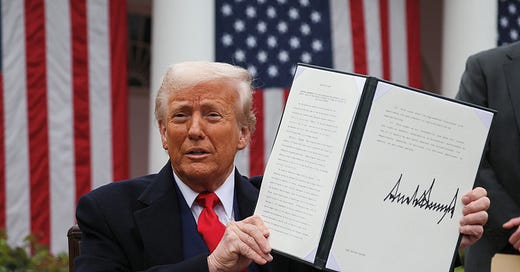Trump’s Tariffs Are a Bid to Reclaim U.S. Manufacturing
A sharp break from post-WWII trade consensus. Subscribe for full access.
If maintained, President Trump’s sweeping tariffs could spark an economic mission steeped in defiant nostalgia: an effort to reestablish the United States as a dominant force in global manufacturing.
Many economists and business leaders remain skeptical that Trump’s tariffs can reverse the long decline in U.S. manufacturing jobs—a shift driven by global forces and automation. However, few dispute that deindustrialization inflicted deep, lasting harm that went largely ignored.
A recent M.I.T. study on the early 2000s “China Shock” found that while some affected regions have partly rebounded, many displaced workers have not. Factory jobs began moving overseas in the late 1970s as U.S. corporations sought lower costs abroad. The shift toward free trade was deliberate, pursued for cheaper goods despite the toll on domestic industry.
“The funny thing about finance and economics is that we don’t really advance or learn anything over time, we just cycle through the same things, over and over, in different ways,” Brent Donnelly, the president of Spectra Markets, a market research firm, told The New York Times. “We vilify mercantilism and lionize free trade but are forced to rethink these religions when income inequality shatters social cohesion and decades of unreciprocated tariff cuts create an unlevel playing field.”
During the postwar manufacturing boom that lasted into the 1970s, close to 20 million Americans earned their living in factories. The U.S. led the world in producing automobiles, airplanes, and steel, with manufacturing providing more than a quarter of all jobs.
The Economy Has Fundametally Shifted
But after decades of economic transformation, only about 8 percent of American workers were employed in manufacturing by the end of last year. Today, the nation is more prosperous than ever, yet its economy has fundamentally shifted. Services of every kind—ranging from highly paid professions to low-wage gigs—now drive growth.
The U.S. is a global leader in exporting services like banking, insurance, consulting, and legal expertise. It also exports key goods such as aircraft, soybeans, and oil. But over time, it has grown more reliant on other countries for many consumer products, including electronics, clothing, and other everyday items. Meanwhile, many industrial centers across the American heartland have faded, leaving key parts of Trump’s political base on the economic sidelines.
Trump’s Rose Garden announcement Wednesday marked a sharp break from decades of bipartisan support for global free trade, signaling a full embrace of economic nationalism. “Jobs and factories will come roaring back into our country,” Trump said in a Rose Garden ceremony. “If you want your tariff rate to be zero, then you build your product right here in America.”
The sweeping plan imposes a baseline 10% tariff on nearly all imports and far higher levies on specific countries. China faces a combined tariff load of up to 70%, while Vietnam was hit with a new 46% duty and the European Union with 20%.
The administration’s goal is clear: to reindustrialize the U.S. by forcing companies to relocate production and investment away from foreign supply chains and back home.
It’s a dramatic reversal of the post-World War II consensus that economic integration and trade fostered global prosperity—and secured American leadership.
Keep reading with a 7-day free trial
Subscribe to The Rising Tide to keep reading this post and get 7 days of free access to the full post archives.




